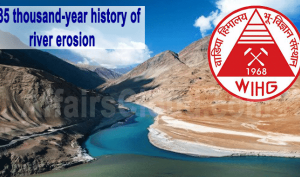
- Scientists and students from Wadia Institute of Himalayan Geology(WIHG), an autonomous institute under the Department of Science &Technology, in the study, published in the Global and Planetary Changes journal has revealed a 35 thousand-year history of river erosion and identified hotspots of erosion and wide valleys that act a buffer zones in Ladakh Himalayas
- The research shows how rivers in drier Ladakh Himalaya are operating on longer time scales and how they respond to varying climates, an understanding of water and sediment routing, which is important as the country improves its infrastructure and develops smart cities.
- It helpsTo understand the landform evolution in transitional climatic zone the Zanskar catchment was explored by WIHG team by using morpho stratigraphy and origin study of landforms like valley fill terraces, alluvial fans (triangle-shaped deposit of gravel, sand, and even smaller pieces of sediment, such as silt).
About WIHG:
- It was established in June 1968Objectives – To undertake, aid, promote, guide and coordinate research in geology of the Himalaya and foster a tradition of scholarships.
- Headquarters– Dehradun, Uttarakhand

